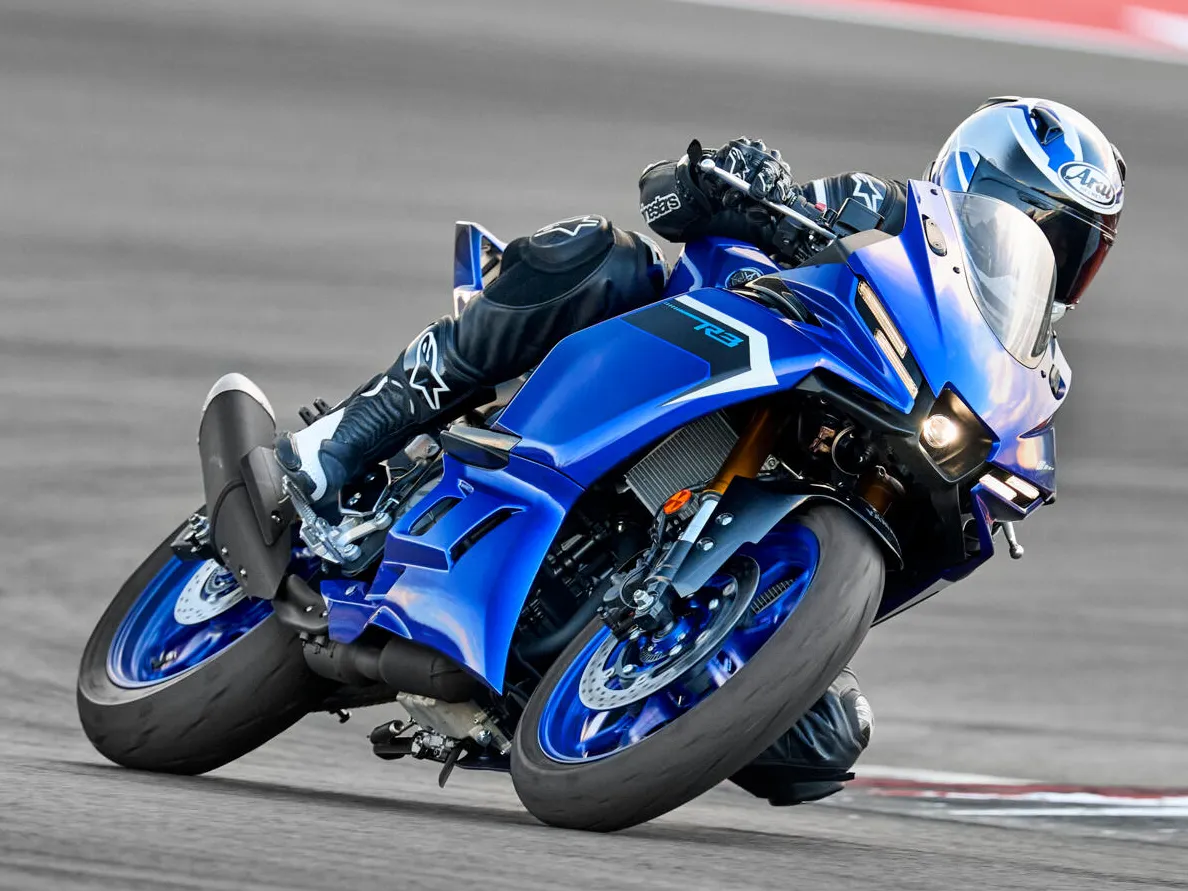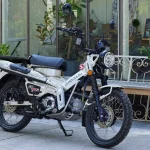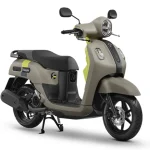The 2025 model of the YZF-R3, which is being developed in Japan as an upper model of the YZF-R25, has been announced in Europe and North America. We will introduce the various parts of the new R3, which has been significantly refined, mainly in the European specifications.
The YZF-R3/25 was introduced into the new era of 250cc sports motorcycles
The 2008 release of the Kawasaki Ninja250R marked the return of a road sports motorcycle to the 250cc class. With a steel frame and a parallel twin-cylinder engine, the Ninja250R felt lacking compared to the racer replicas of the heyday, but contrary to most expectations, it became a huge hit. It proved that there was interest in 250cc class sports motorcycles, and each manufacturer began developing sports models for a new era.
Yamaha released the YZF-R25 in the Japanese market in 2014, and the following year in 2015, the higher-end model, the YZF-R3, also debuted. In Japan, the YZF-R25 is the main model due to the vehicle inspection system, but the R3 was originally developed as a global model and is sold all over the world. These two models are siblings that share a common body, with the R3 having a 321cc engine with a bore and stroke of 68 x 44.1mm (European spec), while the R25 has a 259cc engine with a bore and stroke of 60 x 44.1mm.
In 2019, major changes were made to the body design, with the front fork changed from a 41mm upright type to a 37mm inverted type, and the model was redesigned to the current style with a full LCD meter and LED headlights.
The current model is now in its fifth year on the market, and rumors of a new model were beginning to circulate, but on October 9th, the new YZF-R3 was announced in Europe along with the new YZF-R9 model.

The new R3 is given the latest design of the YZF-R series, giving it a stronger sporty image, and is expected to perform well on the circuit.

The R25/R3 concept of "a superbike that can be ridden every day" has been inherited, and the riding position is set upright for a sports motorcycle.

The first-generation YZF-R3 featured a distinctive inverted slant nose at the front. It was a successful lightweight sports model that was sold globally.

The second generation model was equipped with an inverted fork at the front, and the front design was changed to follow that of the YZF-R1 at the time.

The third-generation model that has just been released features sharper headlights and winglets inherited from MotoGP machines.

The YZF-R9 equipped with the CP3 engine, announced at the same time as the R3, is a more serious sports model, as can be seen from the R1's low handlebar position.
Adopts a more sophisticated new YZF series design
First, let's look at the design of the new YZF-R3. It has a projector headlight built into the duct in the center, which is also used in the new YZF-R series and the YZF-R9 announced at the same time, and has LED headlights and position lights on both sides.

The headlights feature the latest YZF-R series design, with projector lights in the center and LED lights on the sides.
Under the distinctive air ducts, winglets derived from the YZF-M1 works racer are newly installed. These winglets work in conjunction with the tail wing at the seat end and the new bodywork, and are designed to maximize aerodynamic efficiency as air flows along the body.

The large overhanging ducts and winglets are designed with feedback from MotoGP machines.

Wings are also designed on the seat cowl. This is another feature that incorporates the latest MotoGP trends.
The seat is up to 6 mm wider and the side covers are up to 13 mm slimmer, reducing the amount of bodywork blocking the legs, and the lower seat height of 780 mm improves leg room. The vehicle's light weight of 169 kg with a full tank of fuel has also improved its ease of handling.

The design of the seats and side covers has been refined, and the lower seat height improves leg room.

Side view with a sense of sharpness. Since the frame and suspension are based on the previous generation, the dimensions do not seem to change significantly.

The winglets and duct design give the front a voluminous appearance, while the rear is narrower.

The main color is Icon Blue, which is also the image color of the YZF-R series.

Another color available is Midnight Black with minimal graphics and accents.

In addition to blue and black, North America will have its own color, Lunar White x Nebula Blue.

We expect that many of the flashy colors of the YZF-R25/R3 will be introduced to Japan these days.
The engine and chassis are based on the previous model, but improvements have been made to each part to improve ease of use.
A notable feature of the new R3's performance is the inclusion of an assist and slipper clutch, which makes gear shifting smoother and downshifting seamless. In addition, the optional Quick Shift System (QSS) can be installed to achieve faster and smoother upshifts. In addition, the lever operation is at least 17% lighter than the standard clutch system, and the clutch lever has been moved 5 mm closer to the handlebar, making it easier for riders with small hands to operate while riding, minimizing fatigue.

The engine is a 321cc parallel twin-cylinder, mounted on a steel diamond-type frame.
One notable performance feature of the new R3 is its assist and slipper clutch. This makes gear shifting smoother and downshifting more seamless. In addition, the optional Quick Shift System (QSS) can be incorporated for faster and smoother upshifts. In addition, the lever operation is at least 17% lighter than the standard clutch system, and the clutch lever is 5 mm closer to the handlebar, which minimizes fatigue by making it easier for riders with smaller hands to operate while riding.

The adoption of an assist & slipper clutch and the fact that the clutch lever has been moved 5mm closer make it easier to control the clutch.
The meter is a newly designed full LCD display type, and it can be connected to a smartphone via the "MyRide" app. This gives the user a wealth of data about the bike, and calls, texts, email notifications, and more are displayed on the meter.

The meter is a new design full LCD display type. The speed is displayed as numbers and the engine RPM as a bar.
The app displays the last parked position of the bike, fuel consumption, engine RPM and throttle opening, acceleration rate, eco-friendly riding indicators, etc. In addition, you can rank your rides compared to other MyRide users, and create a personal riding log including map route, average speed, weather and temperature, altitude, etc. every time the rider sets off on a new journey. In addition, a USB-A type port, which is essential for charging smartphones, is also standard equipment, making it highly practical.

The USB port, which has become a necessity, is equipped as standard with a Type A port. It also comes with a waterproof cover, so you can use it without worrying about rain.
The 250cc YZF-R25 will of course be available for the domestic market, but it is highly likely that it will be released with almost the same specifications except for the engine displacement. With upgrades to each part just like the R3, we can look forward to the YZF-R25 entering a new phase.

It will be introduced in Japan as a double feature with the R25, as it has been up until now. The release date is still undecided, but we will update Webike+ as soon as we have more information.
YZF-R3 Main Specifications (2025/European Specs)
Overall Length x Width x Height: 2090 x 735 x 1140 mm
Wheelbase: 1380mm
Seat Height: 780mm
Dry Weight: 179kg
Engine: Liquid-cooled 4-stroke DOHC 4-valve 2-cylinder 321cc
Maximum output: 30.9kW (42PS)/10750rpm
Maximum Torque: 29.5N-m (3).(0 kgm)/9000rpm
Fuel Tank Capacity: 14L
Transmission: 6-speed return
Brakes: F=disc, R=disc
Tire: F=110/70-17, R=140/70-17



